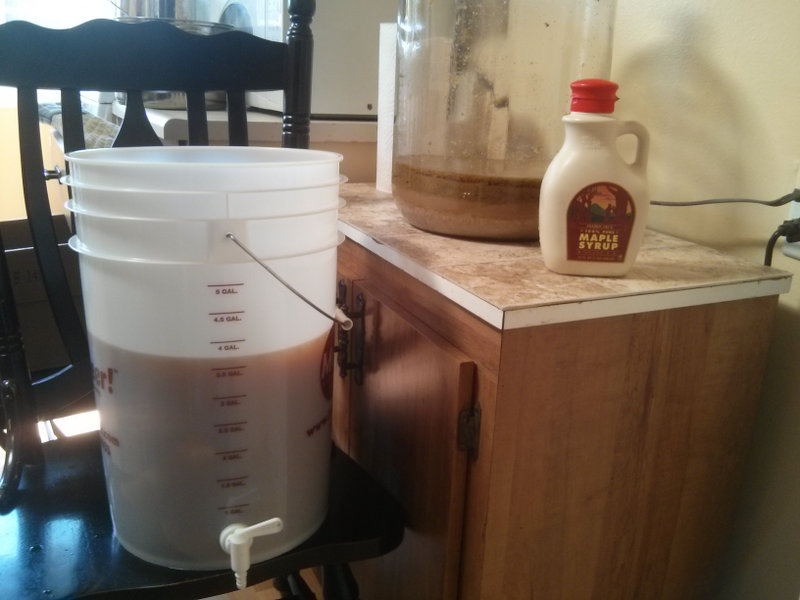"King Tet" IPA
"King Tet" was another SMaSH (Single Malt, Single Hop) beer. This time, the
malt was
Munich
Malt, and the hop was Tettnanger. I reused some of the famous "Conan"
yeast that I used in Golden Promise from the fermenter.
I wasn't really that familiar with Munich malt when I designed this beer. I
knew that Munich malt was "self-converting"-- i.e. that it had enough enzymes
to be mashed by itself with no other grains. And I knew that it was from
Germany, and was highly kilned. But that's about it. So this beer was
somewhat of an experiment.
Since I had chosen a German malt, I figured I would choose a German hop as
well. Tettnanger had a good reputation and there was an 8 ounce bag available,
so I went with that. I decided to go Tettnanger all the way, even for a
bittering hop. This was a bit of an unconventional choice, since Tettnanger
has a pretty low alpha acid percentage of around 4.5%. I had to use double the
amount of hops that I had used in Golden Promise.
One thing that I found out is that adding a lot of hops soaks up a lot of
liquid. The volume of beer in the fermenter was at least 1/2 of a gallon lower
than I expected (although I think part of that was also evaporation.).
I always use an iodine test to ensure that all the starches have converted to
sugars. For some reason, the mash took longer this time than usual. In this
case, it took 2 hours before I was ready to move on from the mash. This could
have been because of the lower level of diastatic enzymes in Munich malt, or it
could be because I was having a little trouble keeping the temperature from
dipping below 150F. It was a windy day.
The recipe was simple:
15 pounds munich (5-7 L)
6 ounces Acidulated Malt (3.0 L)
Gigayeast GY054 "Conan" yeast
60-minute boil
1.75 oz Tettnanger hops at 60 minutes
1.75 oz Tettnanger hops at 10 minutes
1.75 oz Tettnanger hops at 0 minutes
1.75 oz Tettnanger dry-hop for 5 days in secondary
Cold-Side
The beer was fermented in the low 60s. I had some trouble this time because my
new fermenter was too wide to allow the fridge to close completely. I put a
sleeping bag over the door in an ad-hoc attempt at insulation.
I had a lot of trouble last time with using hop bags. So I decided to simply
pitch the hops directly into the fermenter. This turned out to be a bad idea
since it made siphoning really difficult (again). Also, I wasn't able to
really effectively filter the hops out of the beer-- some of the bottles had
some hop debris floating in them. I guess this will settle over time, but it's
still an unpleasant difference compared with Golden Promise.
I think I finally learned my lesson. Don't ever put pellet hops directly into
the fermenter. If someone tells you it is ok, don't believe them. Always use
a bag.
When I came to bottle this beer, I was out of corn sugar. So I decided to do
something a little weird and use maple syrup. I found a calculator online and
adjusted my priming amounts accordingly. I pasteurized the maple syrup in 2
cups of water.

Tasting
The OG for this beer was 1.075, and the FG was 1.011. That's 8.5% alcohol. It
certainly is a heavy beer. Two weeks after I first bottled this, I wasn't very
happy with it. It just seemed too sweet somehow. Also, I had problems with
hop powder floating in the beer, which is just gross.
This beer has gotten a lot better with age, though. The flavor has mellowed
and somehow the hops are better integrated. At this point, it tastes less like
an IPA and more like a somewhat fruity medium-bodied ale. It certainly has
given me a good idea of what Tettnanger tastes like! As usual, I really can't
describe it in words. You will just have to taste it for yourself.
The hop dust problem has improved a little bit. Some bottles seem to have it
much worse than others. Basically anything near that came from near the bottom
of the bottling bucket is still very dusty.
This batch had lots of beer volcanoes with excess carbonation. I wonder if
this is because I primed with maple syrup. Certainly, the amount of sugar in
maple syrup is not as consistent from batch to batch as the 100% powdered corn
sugar I usually use. I have also learned that you should raise the temperature
towards the end of fermentation to ensure that the yeast eats everything it
can-- something I didn't do with this batch. Although I was pretty diligent
about using my hydrometer, I bottle conditioned at a higher temperature than I
fermented, and I wonder if that enabled the yeast to keep working on sugars in
the malt it didn't get to earlier.
I shared about 3 gallons of this beer at the
Hops N Barley homebrew festival in Scotts
Valley. People really liked it there! One guy told me it was the best beer he
had ever tasted. I think one reason people liked it was because most other
homebrewers made traditional pale IPAs, and this beer was very different than
that. Whatever else you can say about it, it has personality... and
personality goes a long way.
